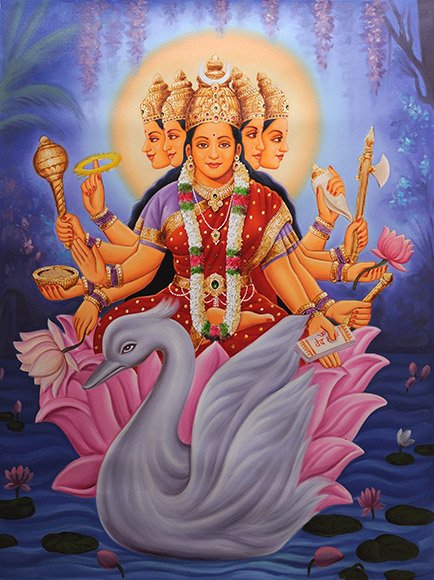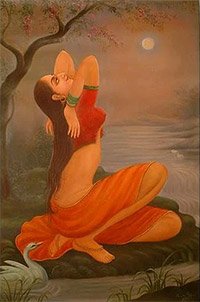Rata, Ratā: 27 definitions
Introduction:
Rata means something in Hinduism, Sanskrit, Jainism, Prakrit, Buddhism, Pali, the history of ancient India, Marathi, Hindi, biology. If you want to know the exact meaning, history, etymology or English translation of this term then check out the descriptions on this page. Add your comment or reference to a book if you want to contribute to this summary article.
Alternative spellings of this word include Raat.
Images (photo gallery)
In Hinduism
Chandas (prosody, study of Sanskrit metres)
Source: Shodhganga: a concise history of Sanskrit Chanda literatureRāta (रात) is the name of a pre-Piṅgalan author on the science of Sanskrit metrics (chandaśāstra): Rāta and Māṇḍavya are two ancient authorities of Sanskrit metrics are also mentioned by Piṅgala in Chandaśśāstra

Chandas (छन्दस्) refers to Sanskrit prosody and represents one of the six Vedangas (auxiliary disciplines belonging to the study of the Vedas). The science of prosody (chandas-shastra) focusses on the study of the poetic meters such as the commonly known twenty-six metres mentioned by Pingalas.
Purana and Itihasa (epic history)
Source: archive.org: Puranic EncyclopediaRatā (रता).—A daughter of Dakṣaprajāpati. Dharma married her and the Vasu called Ahar was born to the couple. (Ādi Parva, Chapter 66, Verse 17).
Source: JatLand: List of Mahabharata people and placesRata (रत) is a name mentioned in the Mahābhārata (cf. I.60.18) and represents one of the many proper names used for people and places. Note: The Mahābhārata (mentioning Rata) is a Sanskrit epic poem consisting of 100,000 ślokas (metrical verses) and is over 2000 years old.

The Purana (पुराण, purāṇas) refers to Sanskrit literature preserving ancient India’s vast cultural history, including historical legends, religious ceremonies, various arts and sciences. The eighteen mahapuranas total over 400,000 shlokas (metrical couplets) and date to at least several centuries BCE.
Ayurveda (science of life)
Source: gurumukhi.ru: Ayurveda glossary of termsRata (रत):—[rataṃ] Indulgent; Habituated

Āyurveda (आयुर्वेद, ayurveda) is a branch of Indian science dealing with medicine, herbalism, taxology, anatomy, surgery, alchemy and related topics. Traditional practice of Āyurveda in ancient India dates back to at least the first millenium BC. Literature is commonly written in Sanskrit using various poetic metres.
Shaivism (Shaiva philosophy)
Source: Brill: Śaivism and the Tantric TraditionsRata (रत) refers to “(being) devoted (to recitation and meditation)”, according to the 9th-century Sarvajñānottaratantra chapter 18.—Accordingly, “Next, I shall teach the best observance among observances, which is known as the Śiva-vrata and which is revered by Asuras and Gods alike. [...] He should dwell constantly in a temple of Śiva, eating alms, controlling his senses, devoted to recitation and meditation (japadhyāna-rata), maintaining silence, venerating Śiva, the fire and his guru. When a year has passed, he will become equal to Śiva. [...]”.

Shaiva (शैव, śaiva) or Shaivism (śaivism) represents a tradition of Hinduism worshiping Shiva as the supreme being. Closely related to Shaktism, Shaiva literature includes a range of scriptures, including Tantras, while the root of this tradition may be traced back to the ancient Vedas.
Kama-shastra (the science of Love-making)
Source: Brill: Śaivism and the Tantric Traditions (kāmasūtra)Rata (रत) refers to “sex” (=‘practicing sex’), according to the Kāmasūtra of Vātsyāyana and Jaśodhara’s commentary called the Jayamaṅgalā .—Accordingly, “[When you are] about to practise sex (rata—ratasyopakrame), [first you should] rub her genitalia with your hand, and when there is dampness, the sexual act can be commenced. This is the restoration of passion”.

Kamashastra (कामशास्त्र, kāmaśāstra) deals with ancient Indian science of love-making, passion, emotions and other related topics dealing with the pleasures of the senses.
Natyashastra (theatrics and dramaturgy)
Source: Shodhganga: Literary estimate of mudraraksasaRata (रत) refers to “sexual enjoyment” which should be avoided on a stage (where a dramatic play is performed).—A Nāṭaka should contain pañcasandhis which indicate five successive stages of the drama. This criterion also is present in the Mudrārākṣasa. [...] In the Sāhityadarpaṇa, Viśvanātha gives a list of certain actions which should not be presented on the stage. These are [e.g., sexual enjoyment (rata)] [...].

Natyashastra (नाट्यशास्त्र, nāṭyaśāstra) refers to both the ancient Indian tradition (shastra) of performing arts, (natya—theatrics, drama, dance, music), as well as the name of a Sanskrit work dealing with these subjects. It also teaches the rules for composing Dramatic plays (nataka), construction and performance of Theater, and Poetic works (kavya).
In Jainism
General definition (in Jainism)
Source: archive.org: Personal and geographical names in the Gupta inscriptions (jainism)Rāta (रात) is a Prakrit ending for deriving proper personal names, mentioned as an example in the Aṅgavijjā chapter 26. This chapter includes general rules to follow when deriving proper names. The Aṅgavijjā (mentioning rāta) is an ancient treatise from the 3rd century CE dealing with physiognomic readings, bodily gestures and predictions and was written by a Jain ascetic in 9000 Prakrit stanzas.
Source: archive.org: TrisastisalakapurusacaritraRatā (रता) is the name of a Vidyādhara-city, situated on mount Vaitāḍhya (in the southern row), according to chapter 1.3 [ādīśvara-caritra] of Hemacandra’s 11th century Triṣaṣṭiśalākāpuruṣacaritra: an ancient Sanskrit epic poem narrating the history and legends of sixty-three illustrious persons in Jainism.
Accordingly,
“[...] Taking their families and all their retinue and ascending the best of cars, they went to Vaitāḍhya. [...] Ten yojanas above the earth, King Nami made fifty cities on the mountain in a southern row [viz., Ratā]. Nami himself lived in Śrīrathanūpuracakravāla, the capital city among these cities. [...] The two rows of Vidyādhara-cities looked very magnificent, as if the Vyantara rows above were reflected below. After making many villages [viz., Ratā] and suburbs, they established communities according to the suitability of place. The communities there were called by the same name as the community from which the men had been brought and put there. [...]”.

Jainism is an Indian religion of Dharma whose doctrine revolves around harmlessness (ahimsa) towards every living being. The two major branches (Digambara and Svetambara) of Jainism stimulate self-control (or, shramana, ‘self-reliance’) and spiritual development through a path of peace for the soul to progess to the ultimate goal.
India history and geography
Source: Cologne Digital Sanskrit Dictionaries: Indian Epigraphical GlossaryRāta.—(BL), modification of or mistake for Rāvata or Rāuta. Note: rāta is defined in the “Indian epigraphical glossary” as it can be found on ancient inscriptions commonly written in Sanskrit, Prakrit or Dravidian languages.

The history of India traces the identification of countries, villages, towns and other regions of India, as well as mythology, zoology, royal dynasties, rulers, tribes, local festivities and traditions and regional languages. Ancient India enjoyed religious freedom and encourages the path of Dharma, a concept common to Buddhism, Hinduism, and Jainism.
Biology (plants and animals)
Source: Google Books: CRC World Dictionary (Regional names)1) Rata in Maori is the name of a plant defined with Metrosideros umbellata in various botanical sources. This page contains potential references in Ayurveda, modern medicine, and other folk traditions or local practices It has the synonym Agalmanthus umbellata (Cav.) Hombr. & Jacquinot.
2) Rata in Tanzania is also identified with Kigelia pinnata It has the synonym Bignonia africana Lam. (etc.).
3) Rata is also identified with Kigelia africana It has the synonym Sotor aethiopium Fenzl (etc.).
4) Rata in Vernacular names is also identified with Inocarpus fagifer It has the synonym Bocoa edulis (J.R. Forst. & G. Forst.) Baill. (etc.).
Example references for further research on medicinal uses or toxicity (see latin names for full list):
· Flora of Tropical Africa (1936)
· Encyclopédie Méthodique, Botanique (Lamarck) (1785)
· The Useful Plants of West Tropical Africa. (1985)
· Revisio Generum Plantarum (1891)
· Journal of the Washington Academy of Sciences (1941)
· Journal of a voyage to the South Seas (1773)
If you are looking for specific details regarding Rata, for example chemical composition, pregnancy safety, diet and recipes, health benefits, side effects, extract dosage, have a look at these references.

This sections includes definitions from the five kingdoms of living things: Animals, Plants, Fungi, Protists and Monera. It will include both the official binomial nomenclature (scientific names usually in Latin) as well as regional spellings and variants.
Languages of India and abroad
Pali-English dictionary
Source: BuddhaSasana: Concise Pali-English Dictionaryrata : (pp. of ramati) delighted in; devoted to; enjoyed oneself.
Source: Sutta: The Pali Text Society's Pali-English DictionaryRata, (pp. of ramati) delighting in (Loc. or —°), intent on, devoted to S. IV, 117 (dhamme jhāne), 389 sq. (bhava° etc.); Sn. 54 (saṅgaṇika°) 212, 250, 327, 330 (dhamme), 461 (yaññe), 737 (upasame); Mhvs. 1, 44 (mahākāruṇiko Satthā sabba-loka-hite rato); 32, 84 (rato puññe); PvA. 3, 12, 19 (°mānasa). (Page 563)

Pali is the language of the Tipiṭaka, which is the sacred canon of Theravāda Buddhism and contains much of the Buddha’s speech. Closeley related to Sanskrit, both languages are used interchangeably between religions.
Marathi-English dictionary
Source: DDSA: The Molesworth Marathi and English Dictionaryraṭa (रट).—a Commonly raṭha or raṇṭha.
--- OR ---
rata (रत).—n (S) Coition.
--- OR ---
rata (रत).—p (S) Enamoured of; captivated with; fondly engaged by or attached to. Ex. of compounds--kāmarata, karmarata, viṣayarata, strīrata, dāna-dharma- bhakti-vāda-gāna-adhyayana-rata.
--- OR ---
rāṭa (राट).—m R (Usually rahāṭa) A waterwheel &c.
--- OR ---
rāta (रात).—f (rātri S through H) Night. 2 A cricket.
--- OR ---
rāta (रात).—m C (rakta S) Bloodshotten state of the eyes.
--- OR ---
rātā (राता).—a (rakta S) Red with a slight mixture of black;--used of rice, certain fruits, and esculent roots. 2 Reddish--eyes.
--- OR ---
rātā (राता).—m A kind of rice.
Source: DDSA: The Aryabhusan school dictionary, Marathi-Englishrata (रत).—p Enamouted of.
--- OR ---
rāta (रात).—f Night. A cricket. m Bloodshotten state of the eyea.
--- OR ---
rātā (राता).—a Red with a slight mixture of black. m A kind of rice.
Marathi is an Indo-European language having over 70 million native speakers people in (predominantly) Maharashtra India. Marathi, like many other Indo-Aryan languages, evolved from early forms of Prakrit, which itself is a subset of Sanskrit, one of the most ancient languages of the world.
Sanskrit dictionary
Source: DDSA: The practical Sanskrit-English dictionaryRata (रत).—p. p. [ram-kartari kta]
1) Pleased, delighted, gratified.
2) Pleased or delighted with, fond of, enamoured of, fondly attached to.
3) Inclined to, disposed.
4) Loved, beloved.
5) Intent on, engaged in, devoted to; गोब्राह्मणहिते रतः (gobrāhmaṇahite rataḥ) Manusmṛti 11.78.
6) Having sexual intercourse with (see ram).
-tam 1 Pleasure.
2) Sexual union, coition; अन्वभूत् परिजनाङ्गनारतम् (anvabhūt parijanāṅganāratam) R.19.23,25; Meghadūta 91.
3) The private parts.
--- OR ---
Rāta (रात).—a. Given, bestowed; रातो वोऽनुग्रहार्थाय विष्णुना प्रभविष्णुना (rāto vo'nugrahārthāya viṣṇunā prabhaviṣṇunā) Bhāgavata 1.12.16.
Source: Cologne Digital Sanskrit Dictionaries: Shabda-Sagara Sanskrit-English DictionaryRata (रत).—mfn.
(-taḥ-tā-taṃ) Occupied or engaged by, actively intent on. n.
(-taṃ) 1. Copulation, sexual union. 2. Pleasure. 3. A privity, a private part. E. ram to sport, kta aff.
Source: Cologne Digital Sanskrit Dictionaries: Cappeller Sanskrit-English DictionaryRata (रत).—[adjective] content, happy, glad, merry; pleased with, devoted to, fond of ([locative], [instrumental], or —°); dallying or having sexual intercourse with (—°).
--- OR ---
Rāta (रात).—[adjective] given (often °— or —°).
Source: Cologne Digital Sanskrit Dictionaries: Aufrecht Catalogus CatalogorumRāta (रात) as mentioned in Aufrecht’s Catalogus Catalogorum:—quoted by Piṅgala. Ind. Studien 8, 406.
Source: Cologne Digital Sanskrit Dictionaries: Monier-Williams Sanskrit-English Dictionary1) Rata (रत):—a rati etc. See under √ram, p.867, [columns] 2, 3.
2) [from ram] b mfn. pleased, amused, gratified, [Bhāgavata-purāṇa]
3) [v.s. ...] delighting in, intent upon, fond or enamoured of, devoted or attached or addicted or disposed to ([locative case] [instrumental case] or [compound]), [Śatapatha-brāhmaṇa] etc. etc.
4) [v.s. ...] (ifc.) having sexual intercourse with, [Bhāgavata-purāṇa]
5) [v.s. ...] loved, beloved, [Monier-Williams’ Sanskrit-English Dictionary]
6) Ratā (रता):—[from rata > ram] f. Name of the mother of Day, [Mahābhārata]
7) Rata (रत):—[from ram] n. pleasure, enjoyment, ([especially]) enjoyment of love, sexual union, copulation, [Kāvya literature; Varāha-mihira] etc.
8) [v.s. ...] the private parts, [cf. Lexicographers, esp. such as amarasiṃha, halāyudha, hemacandra, etc.]
9) Rāta (रात):—[from rās] a mfn. given, presented, bestowed, [Ṛg-veda] etc. etc. (often ifc.; cf. asmad-, deva-, brahma-r. etc.)
10) [v.s. ...] m. Name of a teacher, [Piṅgala Scholiast, i.e. halāyudha [Scholiast or Commentator]]
11) b rāti etc. See p. 871, col. 3.
Source: Cologne Digital Sanskrit Dictionaries: Yates Sanskrit-English DictionaryRata (रत):—[(taḥ-tā-taṃ) a.] Intent on, devoted to. n. Coition; a privity.
Source: DDSA: Paia-sadda-mahannavo; a comprehensive Prakrit Hindi dictionary (S)Rata (रत) in the Sanskrit language is related to the Prakrit words: Kilikiṃcia, Koḍḍamia, Moṭṭāia, Ramia, Raya.
[Sanskrit to German]
Sanskrit, also spelled संस्कृतम् (saṃskṛtam), is an ancient language of India commonly seen as the grandmother of the Indo-European language family (even English!). Closely allied with Prakrit and Pali, Sanskrit is more exhaustive in both grammar and terms and has the most extensive collection of literature in the world, greatly surpassing its sister-languages Greek and Latin.
Hindi dictionary
Source: DDSA: A practical Hindi-English dictionary1) Raṭa (रट) [Also spelled rat]:—(nf) constant reception/reiteration.
2) Rata (रत) [Also spelled rat]:—(a) attached, loving; used as a suffix to mean engaged in, occupied with (as [kāryarata]); (nm) an allomorph of '[rāta]' used as the first member in certain compound words; ~[jagā] keeping awake the whole night (to celebrate a happy occasion through singing devotional songs or otherwise).
3) Rāta (रात) [Also spelled raat]:—(nf) (the) night: —[kā rājā] an owl; -[dina] day and night; ever, always, at all times; ~[rānī] a typical fragrant flower that blooms during the night, also called rajanigandha:; —[āṃkhoṃ meṃ kāṭanā] to keep wide awake the whole night, not to have a wink through the night; —[ko rāta dina ko dina na samajhanā] lit. to make no distinction between day and night, to work day and night; —[gaharānā] the night to advance; —[ḍhalanā] a substantial part of the night to pass; —[dina kā aṃtara] lit. difference of day and night—vast difference; —[bhara kāma meṃ juṭe rahanā] to burn the midnight oil; —[bhara roe eka na marā] to run round in circles, be fussily busy with little results.
...
Kannada-English dictionary
Source: Alar: Kannada-English corpusRata (ರತ):—
1) [adjective] addicted to; devoted to; occupied in; engaged in; deeply interested in.
2) [adjective] pleased; delighted; satisfied.
3) [adjective] captivated; charmed; enamoured.
--- OR ---
Rata (ರತ):—
1) [noun] the state of being deeply engaged, immersed, involved in.
2) [noun] pleasure; delight.
3) [noun] sexual copulation.
--- OR ---
Rāṭa (ರಾಟ):—[noun] a particular lock or hold in wrestling.
Kannada is a Dravidian language (as opposed to the Indo-European language family) mainly spoken in the southwestern region of India.
Nepali dictionary
Source: unoes: Nepali-English Dictionary1) Rata (रत):—n. 1. love; infatuation; 2. sexual intercourse; copulation; coitus; adj. 1. dedicated; devoted; engrossed; 2. delighted; attracted to; enchanted; tempted;
2) Rāta (रात):—n. night (opposite of day); n. day and night; adv. day and night; at all times;
3) Rātā (राता):—adj./n. pl. of रातो [rāto]
Nepali is the primary language of the Nepalese people counting almost 20 million native speakers. The country of Nepal is situated in the Himalaya mountain range to the north of India.
See also (Relevant definitions)
Starts with (+193): Rata bawlath vael, Rata bwlath wal, Rata indramana, Rata indrana, Rata tora, Rata-bel, Rata-del, Rata-gogan, Rata-indrayan, Rata-rahe-agrakha-palaumcha, Rataba, Ratabandha, Ratabirata, Ratacaptami, Ratad, Ratada, Ratadi, Ratadina, Ratagriha, Rataguru.
Ends with (+1617): Aamrata, Aananta Vrata, Ababhrata, Abadhakavrata, Abhadrata, Abhayavrata, Abhinilanetrata, Abhirata, Abhyasarata, Acalabhrata, Acaranirata, Acararata, Acarata, Acaratapacarata, Acauryanuvrata, Acchidrata, Achalabhrata, Achauryanuvrata, Acisanthera quadrata, Adabdhavrata.
Full-text (+364): Ratakila, Ratanidhi, Ratajvara, Rataguru, Dirgharata, Vadarata, Surata, Ratarthin, Ratashayin, Nirata, Catushpatharata, Pashcimottara, Ramia, Ratayani, Bhagavadrata, Ra, Ratatali, Ratatalin, Aratatrapa, Panarata.
Relevant text
Search found 53 books and stories containing Rata, Ratā, Rātā, Rāta, Rāṭa, Raṭa, Raata; (plurals include: Ratas, Ratās, Rātās, Rātas, Rāṭas, Raṭas, Raatas). You can also click to the full overview containing English textual excerpts. Below are direct links for the most relevant articles:
Isha Upanishad (by A.C. Bhaktivedanta Swami Prabhupada)
Rig Veda (translation and commentary) (by H. H. Wilson)
Garga Samhita (English) (by Danavir Goswami)
Verse 1.18.16 < [Chapter 18 - Vision of the Universal Form]
Verse 2.24.11 < [Chapter 24 - The Story of Asuri Muni in the Rāsa-dance Pastime]
Verse 2.8.11 < [Chapter 8 - Description of Seeing Lord Kṛṣṇa]
Isopanisad (Madhva commentary) (by Srisa Chandra Vasu)
Brihad Bhagavatamrita (commentary) (by Śrī Śrīmad Bhaktivedānta Nārāyana Gosvāmī Mahārāja)
Verse 2.1.113-116 < [Chapter 1 - Vairāgya (renunciation)]
Verse 1.4.55 < [Chapter 4 - Bhakta (the devotee)]
Verse 2.2.222 < [Chapter 2 - Jñāna (knowledge)]

